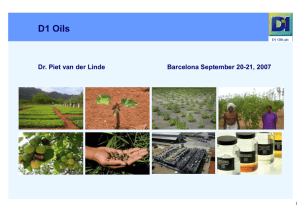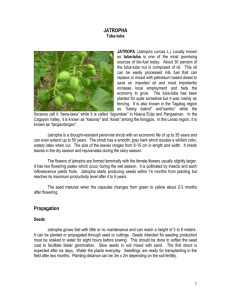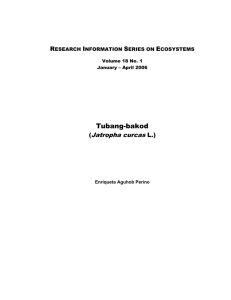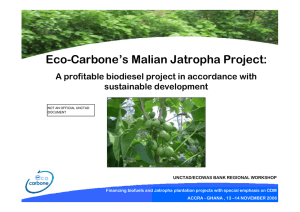JATROPHA
advertisement
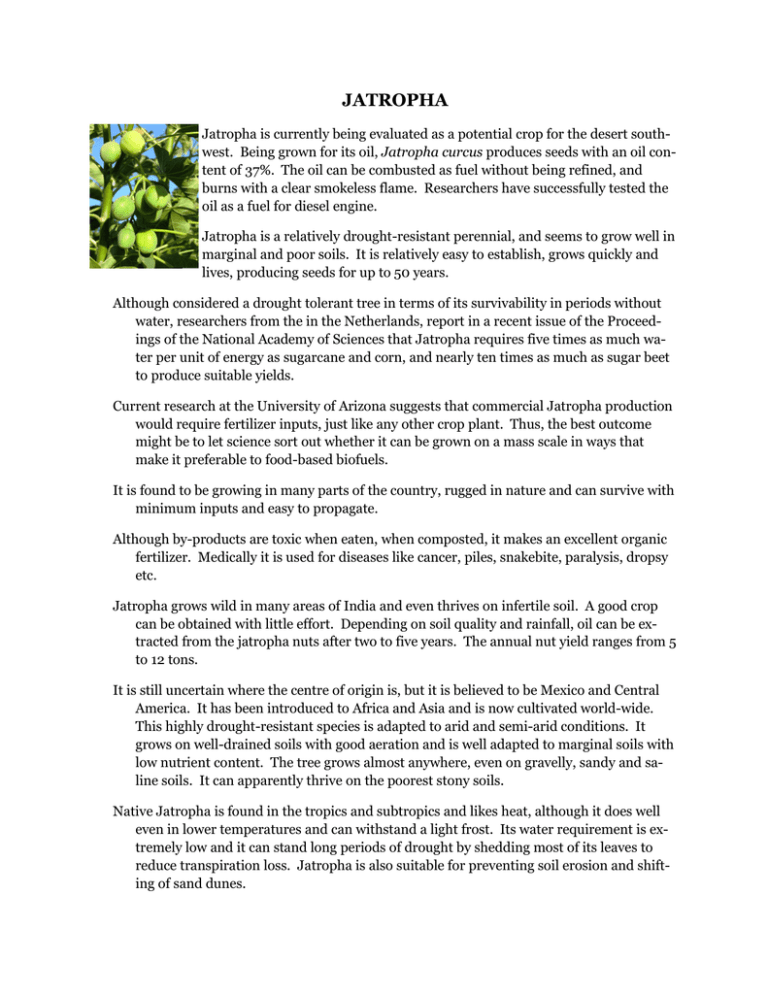
JATROPHA Jatropha is currently being evaluated as a potential crop for the desert southwest. Being grown for its oil, Jatropha curcus produces seeds with an oil content of 37%. The oil can be combusted as fuel without being refined, and burns with a clear smokeless flame. Researchers have successfully tested the oil as a fuel for diesel engine. Jatropha is a relatively drought-resistant perennial, and seems to grow well in marginal and poor soils. It is relatively easy to establish, grows quickly and lives, producing seeds for up to 50 years. Although considered a drought tolerant tree in terms of its survivability in periods without water, researchers from the in the Netherlands, report in a recent issue of the Proceedings of the National Academy of Sciences that Jatropha requires five times as much water per unit of energy as sugarcane and corn, and nearly ten times as much as sugar beet to produce suitable yields. Current research at the University of Arizona suggests that commercial Jatropha production would require fertilizer inputs, just like any other crop plant. Thus, the best outcome might be to let science sort out whether it can be grown on a mass scale in ways that make it preferable to food-based biofuels. It is found to be growing in many parts of the country, rugged in nature and can survive with minimum inputs and easy to propagate. Although by-products are toxic when eaten, when composted, it makes an excellent organic fertilizer. Medically it is used for diseases like cancer, piles, snakebite, paralysis, dropsy etc. Jatropha grows wild in many areas of India and even thrives on infertile soil. A good crop can be obtained with little effort. Depending on soil quality and rainfall, oil can be extracted from the jatropha nuts after two to five years. The annual nut yield ranges from 5 to 12 tons. It is still uncertain where the centre of origin is, but it is believed to be Mexico and Central America. It has been introduced to Africa and Asia and is now cultivated world-wide. This highly drought-resistant species is adapted to arid and semi-arid conditions. It grows on well-drained soils with good aeration and is well adapted to marginal soils with low nutrient content. The tree grows almost anywhere, even on gravelly, sandy and saline soils. It can apparently thrive on the poorest stony soils. Native Jatropha is found in the tropics and subtropics and likes heat, although it does well even in lower temperatures and can withstand a light frost. Its water requirement is extremely low and it can stand long periods of drought by shedding most of its leaves to reduce transpiration loss. Jatropha is also suitable for preventing soil erosion and shifting of sand dunes. Jatropha trees are productive for up to 30-40 years and over 800 trees can be planted per acre, and yields about 2.6 tons of seed per acre. The oil pressed from 9 pounds of seed is needed to make 1 quart of biodiesel and over 90% of the oil can be extracted with cold pressing. Filtered Jatropha oil can be used as is in many diesel vehicles with only small modifications required to the engine and the pressed oil can be used as a kerosene substitute for heating and lamps. Jatropha grows in tropical and subtropical regions in a band around the earth between latitudes 30 degrees north and south of the Equator. Its seeds are crushed to produce crude Jatropha oil that can be used directly in generators and boilers or refined into biodiesel. Whether Jatropha will turn out to be the wonder plant it was originally touted to be will depend a great deal on how and where it is grown, an issue that must be resolved by scientists, businesses, and governments. Kurt Nolte is an area agriculture agent with the Yuma County Cooperative Extension. He can be reached at 928-726-3904.



